ABC成本分析法
作业成本法(ABC)

合计
280,000,000 174,500,000 62.3% 105,500,000 37.7%
而按 产量来进行间接成本分摊的情况是: 硬盒: 75%
软盒: 25%
23
作业成本法的一个简单的案例
作业成本法的间接成本分摊的情况如下:
硬盒:
每箱所分摊的间接成本= 174,500,000
300,000
A)便于企业管理层掌握各产品成本间的差异 B)为企业所获取的计划外生产指标在各产品间的合理分配提供正确的成本依据 C)为企业成本控制、流程改善、兼并重组提供依据 D)需建立在企业内高度信息化的平台之上
13
第二部分 实用举例
14
作业成本法的一个简单的案例
说明: 考虑到涉及企业机密问题,案例中隐去了企业的名称和品 牌,并对所用的数据在原有的基础上做了相应的调整,但这 些并不会影响最后的结果。
软盒
活动
每项活动的成本
机器设备折旧
机器设备修理
1,000,000
机器的启动和工作时间 20,000
质量的检查 管理人员的活动
10,000 20,000
软盒
20 300 450 1250
软盒 50,000,000 20,000,000 6,000,000 4,500,000 25,000,000
•机器设备折旧分摊的成本由产品线的相关情 况直接得到
15
作业成本法的一个简单的案例
•某烟草生产厂某品牌的香烟有硬盒和软盒两条产品线,2000年硬盒产量 为:30万箱;软盒为:10万箱 •2000年间接成本:2.8亿元 •企业当前采用的是根据产量来进行间接成本的分摊(全厂范围内的分摊) 则:每箱所分摊的间接成本为:
总产总量体(间硬接盒成+本软盒)=
ABC成本分析(1)

One.ABC核心:作业分析传统的成本计算方法传统的成本计算是采用分批法归集产品的制造成本。
每件产品的成本,是直接材料实际的成本、间接成本的总和。
如计算某公司A、B、C三种产品的成本,简单地说,传统的"分批归集"中,除了算入消耗的直接材料成本之外,就是将间接费用平均分摊,即尽管A、B、C三种产品的复杂程度、制造工艺都不相同,却仍然是生产A、B、C三种产品消耗的整体生产能力平均分配,而不是按照三种产品的区分,单独计算每种产品的间接费用比例。
传统成本法割裂和模糊了成本与其产生原因之间的关系,导致了成本分析和控制的失效。
作业成本法(Activity-based Costing)作业成本法(ABC)正是以成本动因为基础,利用财务方法和IT工本管理,不仅可以提供相对准确的成本信息,还可依据作业链和价值链的分析,满足经营控制的需要。
掌握一,进行作业分析和二,成本动因理论,是成功实施ABC的关键。
一,作业成本法运用关键:作业分析作业成本法是以与传统成本计算方法不同的观点看待产品的制作业成本法是基于"作业",而不是基于"产品"。
也就是说,将典型的作业单元进行划分,然后按照每种作业所消耗资源的比例,分配间接费用。
这样的话,归集到每种产品的成本,就取决于它所包含的"成本动因",即直接构成产品的、若干个消耗成本的作业单元的组合。
作业是指在一个组织内为了某一目的而进行的耗费资源的工作。
作业分析是通过对作业的识别与计量,资源费用的归集与确认,成本对象消耗作业的确认与计量,成本费用的归集等步骤和方法,分析评价作业的有效性和增值性,以提高作业效率、减少资源消耗、增加产出价值的一种分析方法。
作业分析从分析层次上可以分为资源动因分析、作业动因分析和作业综合分析三部分。
1,资源动因分析:评价作业有效性资源动因是指资源被消耗的方式和原因,资源动因分析的程序可以分为:调查产品从设计、试制、生产、储备、销售、运输到用户使用的全过程,在熟悉产品生命周期流程的基础上识别、计量作业,并将作业适当合并,建立作业中心;归集资源费用到各相应的作业;分析执行作业消耗资源的情况,确定作业的有效性。
ABC分析法
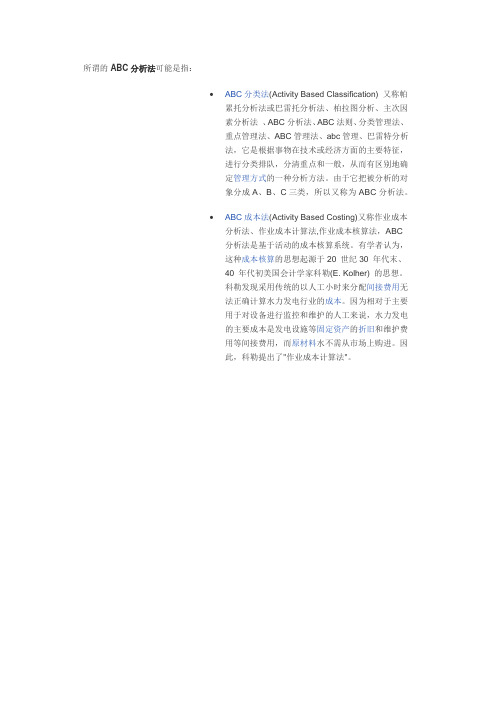
所谓的ABC分析法可能是指:
∙ABC分类法(Activity Based Classification) 又称帕
累托分析法或巴雷托分析法、柏拉图分析、主次因
素分析法、ABC分析法、ABC法则、分类管理法、
重点管理法、ABC管理法、abc管理、巴雷特分析
法,它是根据事物在技术或经济方面的主要特征,
进行分类排队,分清重点和一般,从而有区别地确
定管理方式的一种分析方法。
由于它把被分析的对
象分成A、B、C三类,所以又称为ABC分析法。
∙ABC成本法(Activity Based Costing)又称作业成本
分析法、作业成本计算法,作业成本核算法,ABC
分析法是基于活动的成本核算系统。
有学者认为,
这种成本核算的思想起源于20 世纪30 年代末、
40 年代初美国会计学家科勒(E. Kolher) 的思想。
科勒发现采用传统的以人工小时来分配间接费用无
法正确计算水力发电行业的成本。
因为相对于主要
用于对设备进行监控和维护的人工来说,水力发电
的主要成本是发电设施等固定资产的折旧和维护费
用等间接费用,而原材料水不需从市场上购进。
因
此,科勒提出了"作业成本计算法"。
ABC成本分析法
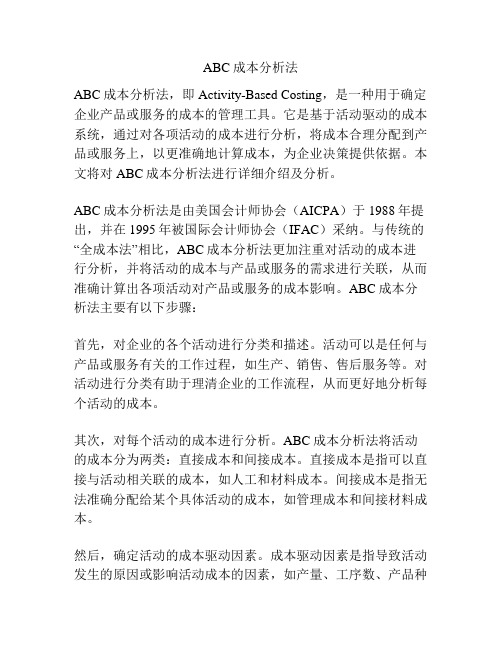
ABC成本分析法ABC成本分析法,即Activity-Based Costing,是一种用于确定企业产品或服务的成本的管理工具。
它是基于活动驱动的成本系统,通过对各项活动的成本进行分析,将成本合理分配到产品或服务上,以更准确地计算成本,为企业决策提供依据。
本文将对ABC成本分析法进行详细介绍及分析。
ABC成本分析法是由美国会计师协会(AICPA)于1988年提出,并在1995年被国际会计师协会(IFAC)采纳。
与传统的“全成本法”相比,ABC成本分析法更加注重对活动的成本进行分析,并将活动的成本与产品或服务的需求进行关联,从而准确计算出各项活动对产品或服务的成本影响。
ABC成本分析法主要有以下步骤:首先,对企业的各个活动进行分类和描述。
活动可以是任何与产品或服务有关的工作过程,如生产、销售、售后服务等。
对活动进行分类有助于理清企业的工作流程,从而更好地分析每个活动的成本。
其次,对每个活动的成本进行分析。
ABC成本分析法将活动的成本分为两类:直接成本和间接成本。
直接成本是指可以直接与活动相关联的成本,如人工和材料成本。
间接成本是指无法准确分配给某个具体活动的成本,如管理成本和间接材料成本。
然后,确定活动的成本驱动因素。
成本驱动因素是指导致活动发生的原因或影响活动成本的因素,如产量、工序数、产品种类等。
通过确定成本驱动因素,可以更准确地将成本分配到各项活动上。
最后,将活动的成本分配到产品或服务上。
根据活动的成本和产品或服务对各个活动的需求程度,可以计算出每个活动对产品或服务的成本影响。
这样一来,就可以更准确地计算出产品或服务的成本,为企业的决策提供参考。
ABC成本分析法有以下的优点:首先,它可以更准确地计算产品或服务的成本。
传统的全成本法往往将成本均摊到产品或服务上,忽略了各项活动对成本的影响。
而ABC成本分析法通过对各项活动的成本进行分析,将成本合理分配到产品或服务上,可以更准确地计算出成本,帮助企业做出更合理的决策。
施工成本分析的方法

施工成本分析的方法
施工成本分析的方法主要有以下几种:
1. 全面成本分析法:该方法将所有与施工相关的成本都列入分析范围,包括直接成本(人工、材料、机械设备等)和间接成本(管理费用、运输费用、税费等),通过逐项分析和核算,得出总成本。
2. ABC成本分析法:ABC(Activity-Based Costing)成本分析法是一种按活动分配成本的方法。
通过将各个活动与产品或项目相关联,按照活动的资源消耗程度来分摊成本,更准确地计算施工成本。
3. 系统价值分析法:该方法将施工过程中的各项成本与项目的效益进行判断和权衡,以确定合理的施工成本。
通过对项目价值进行分析和评估,从而确定成本来源和优化成本。
4. 历史成本法:该方法主要依据历史数据和经验推算施工成本。
通过统计过去类似项目的成本情况,结合目前项目的特点和实际情况,进行成本计算和估算。
5. 比较法:该方法主要通过对多个施工方案或供应商进行成本比较,找出最具经济效益的方案或供应商。
通过对不同方案或供应商的成本进行分析和评估,选择成本最低的方案或供应商。
以上方法可以根据具体的施工项目和情况,综合运用,选取合适的方法进行施工成本分析。
供应链管理系统中的成本核算与分析方法
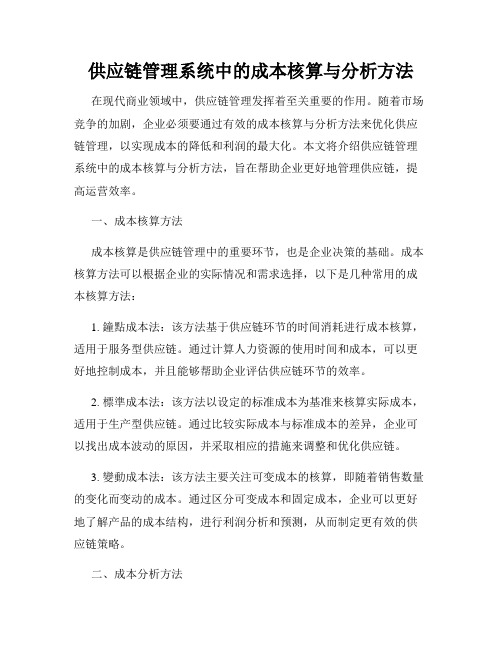
供应链管理系统中的成本核算与分析方法在现代商业领域中,供应链管理发挥着至关重要的作用。
随着市场竞争的加剧,企业必须要通过有效的成本核算与分析方法来优化供应链管理,以实现成本的降低和利润的最大化。
本文将介绍供应链管理系统中的成本核算与分析方法,旨在帮助企业更好地管理供应链,提高运营效率。
一、成本核算方法成本核算是供应链管理中的重要环节,也是企业决策的基础。
成本核算方法可以根据企业的实际情况和需求选择,以下是几种常用的成本核算方法:1. 鐘點成本法:该方法基于供应链环节的时间消耗进行成本核算,适用于服务型供应链。
通过计算人力资源的使用时间和成本,可以更好地控制成本,并且能够帮助企业评估供应链环节的效率。
2. 標準成本法:该方法以设定的标准成本为基准来核算实际成本,适用于生产型供应链。
通过比较实际成本与标准成本的差异,企业可以找出成本波动的原因,并采取相应的措施来调整和优化供应链。
3. 變動成本法:该方法主要关注可变成本的核算,即随着销售数量的变化而变动的成本。
通过区分可变成本和固定成本,企业可以更好地了解产品的成本结构,进行利润分析和预测,从而制定更有效的供应链策略。
二、成本分析方法成本分析是对供应链成本进行细致分析和评估的过程,有助于企业找出成本降低的潜力以及成本波动的原因。
以下是几种常用的成本分析方法:1. ABC成本法:ABC成本法是基于活动消耗的成本核算方法,通过对企业的活动进行分类和成本分配,可以更准确地识别供应链中的高成本环节,并进行针对性的优化。
该方法能够帮助企业更好地了解成本构成,并提供决策依据。
2. 授權價格差異法:该方法主要用于分析供应链中的价格差异,即不同销售渠道或市场的产品销售价格。
通过比较不同价格带来的成本差异,企业可以进行定价策略的调整,以实现成本的最小化和利润的最大化。
3. 效益分析法:效益分析是对供应链中的成本与收益进行综合评估的方法。
该方法可以帮助企业确定供应链中的关键环节,并评估其对企业绩效的影响程度。
ABC成本法

ABC成本法又称作业成本分析法、作业成本计算法,作业成本核算法,是基于活动的成本核算系统。
ABC成本法的产生,最早可以追溯到20世纪杰出的会计大师、美国人()教授。
科勒教授在1952年编着的《会计师词典》中,首次提出了作业、作业帐户、等概念。
1971年,(George Staubus)教授在《作业成本计算和投入产出会计》(Activity Costing and Input Output Accounting)中对"作业"、""、"作业会计"、"作业投入产出系统"等概念作了全面、系统的讨论。
这是理论上研究作业会计的第一部宝贵着作。
但是,当时作业成本法却未能在理论界和实业界引起足够的重视。
20世纪80年代后期,随着、、、的广泛应用,以及、和的兴起,使得美国实业界普遍感到住处与现实脱节,普通存在,且扭曲程度令人吃惊。
的青年学者库伯(Robin Cooper)和教授()注意到这种情况,在对美国公司调查研究之后,发展了斯托布斯的思想,提出了以作业为基础的(1988)(Activity Based Costing,简称ABC法)。
作业成本法在过去10年中受到了广泛的关注,新型的已经扩展了作业成本法的应用范围并研发出相应的软件。
ABC成本法引人了许多新概念,下图显示了计算中各概念之间的关系。
按分配到作业或作业中心,作业成本按分配到。
分配到作业的资源构成该作业的成本要素(图中的黑点),多个成本要素构成作业成本池(中间的小方框),多个作业构成作业中心(中间的椭圆)。
包括和,分别是将资源和作业成本进行分配的依据。
ABC分析法的作用ABC分析法虽然也可作为一个系统使用,但分析特定时点上产品的高低才是它的真正作用。
由于成本动因和企业的业务是变化的,为确保过去的数据和分析结果能够仍然有效,ABC分析也需要定期进行修订。
这种修订应当促使、产品、重点、等战略的改变,从而提高企业的盈利能力。
ABC成本法

作业成本法(ABC):一种新的成本核算方式生产制造是企业的核心流程之一,成本核算则是影响到企业生产制造任务的完成水准的关键。
针对传统成本会计不适应新制造环境的局面,作业成本法(Activity-Based Costing,简称ABC)和基于ABC的作业成本管理(ABCM),在美、日和西欧诸国的企业,尤其是竞争激烈和人工成本很低的高新技术企业,得到了广泛的应用。
一、新制造环境冲击传统成本会计随着企业IT技术的运用,MRPII、ERP、CIM、JIT等系统应用范围不断扩大,企业新制造环境逐渐形成。
企业使用计算机管理信息系统来管理经营与生产,最大限度地发挥现有设备、资源、人、技术的作用,最大限度地产生企业经济效益,已成为制造业企业的一致选择。
从最早的物料需求计划MRP (Material Requirements Planning)、制造资源计划MRPII(Manufacturing Resource Planning)到近年出现的企业资源规划ERP (Enterprise Resource Planning)等,为越来越多的企业采用。
目前流行的MRP Ⅱ有助于管理当局进行及时、有效的投资与生产经营决策;ERP则是建立在信息技术基础上,以系统化的管理思想,为企业决策层及员工提供决策运行手段的管理平台。
不仅是MRP和ERP,促成新制造环境形成的新系统还包括:弹性制造系统(FMS)、电脑整合制造系统(CIM)和适时生产系统(JIT)等。
FMS是指使用机器人及电脑控制的材料处置系统,来结合各种独立的电脑程式机器工具进行生产,它有益于产品制造程序的弹性化。
CIM则是指以电脑为核心,结合电脑辅助设计、电脑辅助工程及电脑辅助制造系统等所有新科技的系统,以形成自动化的制造程序,实现工厂无人化管理,可减少人工成本、节省时间并提高工作效率。
JIT是根据需要来安排生产和采购,以消除企业制造周期中的浪费和损失的管理系统。
在JIT下企业的供、产、销各个环节在时间上必须周密衔接,材料应适时到达现场,前一生产程序的半成品应适时送达后一生产程序,产成品要适时供给顾客,力争使生产经营各个环节无库存储备。
世界500强财务工具ABC成本法

世界500强财务工具ABC成本法【工具定义】ABC(Activity-Based Costing) 成本法又称作业成本分析法、作业成本计算法、作业成本核算法,是基于活动的成本核算系统,是一种通过对所有作业活动进行追踪动态反映,计量作业和成本对象的成本,评价作业业绩和资源的利用情况的成本计算和管理方法。
【适用范围】适用于企业的成本核算工作。
【工具解析】1. 作业成本法的基本模型作业成本法是以作业为中心,根据作业对资源耗费的情况将资源的成本分配到作业中,然后根据产品和服务所耗用的作业量,最终将成本分配到产品与服务。
作业成本法的基本模型如图1所示。
图1作业成本法的基本模型2. ABC成本法引入的新概念ABC成本法引入了许多新概念,图8-16显示了各概念之间的关系。
资源按资源动因分配到作业或作业中心,作业成本按作业动因分配到产品。
分配到作业的资源构成该作业的成本要素(图中的黑点),多个成本要素构成作业成本池(中间的小方框),多个作业构成作业中心(中间的椭圆)。
作业动因包括资源动因和成本动因,分别是将资源和作业成本进行分配的依据。
3. ABC成本法的过程ABC成本法的过程如下。
(1) 定义业务和成本核算对象(通常是产品,有时也可能是客户、产品市场等)。
这一过程很耗时间。
如果两种产品满足的是客户的同一种需求,那么在定义业务时,选择客户要比选择单个产品更为恰当。
(2) 确定每种业务的成本动因,即成本的决定因素,如订单的数量。
(3) 将成本分配给每一成本核算对象,对各对象的成本和价格进行比较,从而确定其盈利能力的高低。
4. ABC 的实施方法(1) 传统的成本核算步骤传统的成本核算分为两个阶段(见图): 第一步包括计量共同成本的不同类别和把它们用适当标准归集到各个生产部门;第二步是用一个数量标准(如直接人工工时、直接材料和机器小时等) 把这些成本分配到各个产品线中。
图作业成本计算中各概念之间的关系22。
ABC成本分析法

企业管理的基本任务是不断地降低成本加强质量。对许多企业而言,“价值"直接取决于企业成本的高低,本文暂且先把质量搁在一旁,在此只讨论成本。刚故去不久的管理大师彼得·德鲁克(Peter Drucker)曾指出:"企业内部只有成本"。
1.2一般成本效益观念
一般成本效益观念源自成本管理,是以企业是否节约为依据,尽力地降低成本乃至力求避免某些费用的发生入手,强调节约和节省。一般成本效益的观念,就是通过成本管理,达到减少支出、降低成本之目的(戈飞平2004)。
图2:一般删减成本方法
2.业务流程再造之中的分析工具
业务流程分析中较常采用的建模与分析方法主要有:行为模型(Activity Modeling)、IDEF0和IDEF1X (IDEF: Integration Definition)、数据建模(Data Modeling)和ABC成本分析法(Activity-Based Costing)等。这些工具分别适用于不同条件下的不同企业所面临不同的问题。(p.119,张继焦2001)
5.结论
ABC为BPR提供有效的成本分析工具。然而,本分析法不见得能应用于所有的产品或服务。在实际操作时,一些成本与作业活动的因果关系并非能完全清楚界定。现时,企业仍多沿用一般成本会计方式,对于ABC作业成本分析法仍然未能完全接受及使用。如今BPR大行其道,ABC作业成本分析法无疑为管理人提供一种有效的分析工具。
3.3第三代ABC成本分析法
第三代ABC成本分析法则着重于对企业所处环境因素加以考量,除了前二代ABC成本分析法寻求之消除浪费、提高效率及降低成本之观念外加入了价值链分析,亦即通过供应商之供料后,就组织内之作业流程包含研究发展、设计、制造、行销、运送、客户服务对流程中每项活动之价值加以分析,在有关辅助性作业纳入之后,企业将更明确获知如何去运用以提高竞争优势,第三代作业流程在于运行过程及资源之上加入价值链分析,于此不再重复图示。
ABC成本分析方法的实施步骤

ABC成本分析方法的实施步骤1. 简介ABC成本分析(Activity-based costing)是一种基于活动驱动的成本管理方法,旨在更准确地计算产品或服务的成本,帮助企业实现有效的成本控制和决策支持。
本文将介绍ABC成本分析方法的实施步骤。
2. 准备工作在实施ABC成本分析之前,需要进行以下准备工作:•确定分析范围:确定需要进行成本分析的产品或服务范围,以便有针对性地收集相关数据。
•定义活动:识别与产品或服务相关的各项活动,并对每个活动进行明确的定义。
•收集数据:收集与每个活动相关的成本数据,包括人工成本、材料成本、设备成本等。
3. 实施步骤3.1 识别活动首先,需要识别与产品或服务相关的各项活动。
活动是产生成本的基本单位,通过识别活动可以更准确地计算成本。
常见的活动包括生产准备、产品设计、采购、生产制造、销售、客户服务等。
3.2 定义活动对于每个识别出的活动,需要进行明确的定义。
定义活动时,可以考虑以下几个方面:•活动名称:给活动起一个清晰明确的名称,便于后续识别和记录。
•活动目的:明确活动的目的和作用,以便更好地理解其价值和必要性。
•活动成本:根据准备工作阶段收集的数据,估计每个活动的成本。
3.3 分配成本在ABC成本分析中,成本的分配是核心步骤之一。
通过分配成本可以将总成本分摊到各个活动上,以便更准确地计算产品或服务的成本。
3.3.1 直接成本分配直接成本是与特定活动直接相关的成本,可以直接追溯到活动的产生。
对于直接成本,可以根据实际发生情况将其分配到相应的活动上。
常见的直接成本包括直接人工成本、直接材料成本等。
3.3.2 间接成本分配间接成本是与多个活动共享的成本,无法直接追溯到某个特定活动。
对于间接成本,需要使用一定的分配方法将其分配到各个活动上。
常见的间接成本分配方法包括人力资源使用率、设备利用率、工作量等。
3.4 计算成本在分配完成本后,可以根据各个活动的成本数据计算产品或服务的成本。
ABC成本法

基于活动的成本管理
01 简介
目录
02 两者区别
03 成本分配的过程
04 成本法
05 组成
06 分析过程
07 实施步骤
09 应用优势
目录
08 应用案例
现代管理学将ABC成本法定义为“基于活动的成本管理”。ABC成本法是根据事物的经济、技术等方面的主要 特征,运用数理统计方法,进行统计、排列和分析,抓住主要矛盾,分清重点与一般,从而有区别地采取管理方 式的一种定量管理方法。
通过对成本信息的分析,发现生产协调、检测、修理和运输作业不增加顾客价值,这些作业的执行人员归属 一个分厂管理,但是人员分布在各个车间。通过作业分析,发现大量的人力资源的冗余。根据分析,可以裁减一 半的人员,并减少相关的资源支出。分析还显示,运输作业由各个车间分别提供,但是都存在能力剩余,将运输 作业集中管理,可以减少三四台叉车。
ABC成本法在企业物流成本核算和管理中的应用 1、物流成本研究的意义及现状物流成本,是指产品在实物 运动过程中,如包装、装卸、储存、流通加工、物流资讯等各个环节所支出的人力、财力、物力和总和。改善企 业内部物流而增加利润成为当今企业管理的热点和重点,被称为“第三利润源泉”。那么这块金矿到底有多大, 如何充分挖掘这块金矿则成为当今企业密切的问题。
ABC成本法主要生产运作过程,加强运作管理,具体活动及相应的成本,同时强化基于活动的成本管理
组成
(1)作业 作业是指需要进行操作并因此消耗资源的流程或程序。比如给供应商打订购就是一个作业。 (2)成本动因是工作的直接原因。成本动因反映了产品或其他成本对象对作业的需求。 如果作业是交付货物,成本动因就是将要被交付的货物的数量。成本动因应该与度量单位起来,并且容易度 量。它们之间的会对作业和交易成本的关系产生影响,即作业是否会影响交易成本。简易的度量可以很容易度量 出作业成本的多少、作业的产品或者服务的使用情况。采购作业的一般成本动因包括申请所要求的货物数量、零 件规格的数量、进度表变动的数量、供应商的数量和延迟交付的数量。 (3)成本对象 需要考核绩效的实体,比如产品、顾客、市场、分销渠道和项目。 (4)作业清单 产品或其他的成本对象所需要的作业及其相关成本的清单。
abc成本法计算的实例

abc成本法计算的实例ABC成本法计算的实例ABC成本法是一种管理会计方法,它通过将成本按照活动进行分配,更准确地计算出产品或服务的成本。
下面将介绍一种使用ABC成本法进行计算的实例,并且按照以下列表进行划分。
一、背景某个制造企业A,其生产的产品分为甲、乙、丙三种,经营状况一直不太理想。
企业A决定采用ABC成本法来计算产品成本,从而优化生产和销售计划。
二、计算方法首先,企业A将所有生产和销售相关的活动进行分类,包括物料采购、生产设备投资、人工成本等。
然后,企业A根据生产活动和销售活动的配比比例来计算每种产品的成本。
三、成本构成企业A结合ABC成本法对每种产品的成本构成进行分析,发现甲类产品的成本主要由人工成本和设备投资组成;乙类产品的成本包括了配送成本以及人工成本;丙类产品的成本构成则主要为人工成本和物料采购成本。
四、成本优化计划通过分析成本构成,企业A决定采取以下优化计划:对于甲类产品,将更多的投资放在相关的设备和人工资源上,从而提高生产效率;对于乙类产品,采用更精细的物流管理,降低配送成本;对于丙类产品,进一步研究物料采购渠道,降低采购价格。
五、效果评估一段时间后,企业A通过ABC成本法再次进行成本计算,发现所有产品的成本均有所降低,并且产量和销量也有所提高。
企业A的利润率和市场占有率也随之上升。
六、总结ABC成本法可以帮助企业更准确地计算产品成本,优化生产和销售计划,提高效率和利润率。
但是,企业在使用ABC成本法时需要注意,需要选择合适的成本分类和计算方法,并且在计算过程中需要保证数据的准确性和完整性。
abc成本法
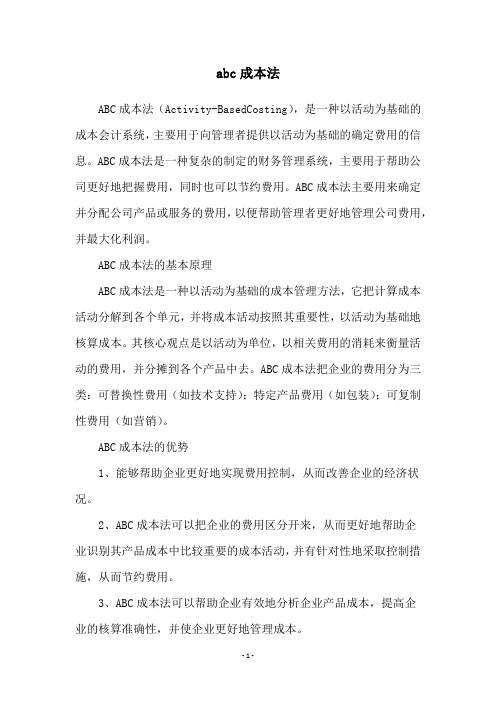
abc成本法
ABC成本法(Activity-BasedCosting),是一种以活动为基础的成本会计系统,主要用于向管理者提供以活动为基础的确定费用的信息。
ABC成本法是一种复杂的制定的财务管理系统,主要用于帮助公司更好地把握费用,同时也可以节约费用。
ABC成本法主要用来确定并分配公司产品或服务的费用,以便帮助管理者更好地管理公司费用,并最大化利润。
ABC成本法的基本原理
ABC成本法是一种以活动为基础的成本管理方法,它把计算成本活动分解到各个单元,并将成本活动按照其重要性,以活动为基础地核算成本。
其核心观点是以活动为单位,以相关费用的消耗来衡量活动的费用,并分摊到各个产品中去。
ABC成本法把企业的费用分为三类:可替换性费用(如技术支持);特定产品费用(如包装);可复制性费用(如营销)。
ABC成本法的优势
1、能够帮助企业更好地实现费用控制,从而改善企业的经济状况。
2、ABC成本法可以把企业的费用区分开来,从而更好地帮助企
业识别其产品成本中比较重要的成本活动,并有针对性地采取控制措施,从而节约费用。
3、ABC成本法可以帮助企业有效地分析企业产品成本,提高企
业的核算准确性,并使企业更好地管理成本。
ABC成本法的应用
ABC成本法在实践中得到了很多企业的应用,企业可以通过利用ABC成本法,更加细致地分解成本,从而更好地控制其产品成本,提高管理效率,同时也可以为企业提供更多有利于企业发展的信息。
以上是关于ABC成本法的介绍,希望本文介绍的ABC成本法能够为企业节省费用,提高企业的效率,同时保持企业的可持续发展。
abc成本法原理

abc成本法原理ABC成本法原理ABC成本法(Activity-Based Costing)是一种用于计算产品或服务成本的管理会计方法。
它通过识别和分配企业各项活动的成本,更准确地反映产品或服务的实际成本,帮助企业进行成本管理和决策分析。
ABC成本法的原理是基于活动的成本分析。
传统的成本计算方法往往将成本仅仅分配到产品的直接材料和直接劳动上,忽略了其他间接成本的影响。
而ABC成本法则通过将企业的各项活动进行识别和分类,将成本分配到各项活动上,再通过活动的驱动因素计算出各项活动的成本,最后再将成本分配到产品或服务上。
ABC成本法的核心是确定活动成本驱动因素。
活动成本驱动因素是指影响活动成本的因素,例如产量、批量、订单数量等。
通过确定活动成本驱动因素,可以更准确地计算活动的成本,从而更精确地计算产品或服务的成本。
ABC成本法的应用包括两个主要步骤:活动分析和成本分析。
活动分析是指对企业各项活动进行识别、分类和评估。
活动分析的目的是了解各项活动对产品或服务成本的影响程度,确定活动成本驱动因素,并建立活动成本驱动因素与活动成本之间的关系模型。
成本分析是指根据活动分析的结果,计算各项活动的成本,并将成本分配到产品或服务上。
成本分析的目的是更准确地确定产品或服务的成本,帮助企业进行成本管理和决策分析。
ABC成本法的优势在于能够更准确地计算产品或服务的成本,帮助企业更好地进行成本管理和决策分析。
相比传统的成本计算方法,ABC成本法能够更好地反映产品或服务的实际成本,避免了将成本错误地分配到产品或服务上的问题。
ABC成本法的应用范围广泛。
它适用于各种不同类型的企业,无论是制造业还是服务业都可以使用ABC成本法进行成本计算。
在制造业,ABC成本法可以帮助企业更好地了解各项活动对产品成本的影响,帮助企业进行成本控制和优化。
在服务业,ABC成本法可以帮助企业更准确地计算服务的成本,为企业提供更好的定价依据。
ABC成本法是一种能够更准确地计算产品或服务成本的管理会计方法。
abc作业成本法的原理
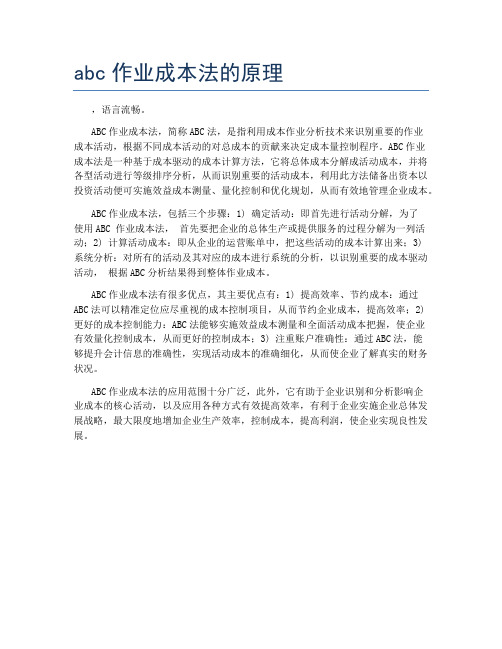
abc作业成本法的原理
,语言流畅。
ABC作业成本法,简称ABC法,是指利用成本作业分析技术来识别重要的作业
成本活动,根据不同成本活动的对总成本的贡献来决定成本量控制程序。
ABC作业
成本法是一种基于成本驱动的成本计算方法,它将总体成本分解成活动成本,并将各型活动进行等级排序分析,从而识别重要的活动成本,利用此方法储备出资本以投资活动便可实施效益成本测量、量化控制和优化规划,从而有效地管理企业成本。
ABC作业成本法,包括三个步骤:1) 确定活动:即首先进行活动分解,为了
使用ABC 作业成本法,首先要把企业的总体生产或提供服务的过程分解为一列活动;2) 计算活动成本:即从企业的运营账单中,把这些活动的成本计算出来;3) 系统分析:对所有的活动及其对应的成本进行系统的分析,以识别重要的成本驱动活动,根据ABC分析结果得到整体作业成本。
ABC作业成本法有很多优点,其主要优点有:1) 提高效率、节约成本:通过ABC法可以精准定位应尽重视的成本控制项目,从而节约企业成本,提高效率;2) 更好的成本控制能力:ABC法能够实施效益成本测量和全面活动成本把握,使企业
有效量化控制成本,从而更好的控制成本;3) 注重账户准确性:通过ABC法,能
够提升会计信息的准确性,实现活动成本的准确细化,从而使企业了解真实的财务状况。
ABC作业成本法的应用范围十分广泛,此外,它有助于企业识别和分析影响企
业成本的核心活动,以及应用各种方式有效提高效率,有利于企业实施企业总体发展战略,最大限度地增加企业生产效率,控制成本,提高利润,使企业实现良性发展。
abc成本法简单说明

abc成本法简单说明abc成本法是一种常用的成本计算方法,它以活动为核心,通过对各项活动的成本进行详细分析,从而准确计算出产品或服务的成本。
下面将简单说明abc成本法的基本原理和应用。
abc成本法的核心思想是将企业的成本分配到各项活动上,然后再将活动的成本分配到产品或服务上。
这种方法与传统的直接成本法和间接成本法不同,它不是简单地按照产品的生产数量或劳动力成本来分配成本,而是更加精确地将成本与实际的活动相关联。
abc成本法的基本步骤如下:第一步,确定活动。
活动是指为实现产品或服务而进行的一系列工作,包括物流、生产、销售等各个环节。
在确定活动时,需要考虑到活动对成本的影响程度以及活动的复杂程度。
第二步,确定活动成本。
活动成本是指与活动相关的各项费用,包括人工费用、设备费用、能源费用等。
通过对活动成本的详细分析,可以了解到各项活动对总成本的贡献程度。
第三步,确定成本驱动因素。
成本驱动因素是指影响活动成本的关键因素,例如生产数量、工作时间、设备利用率等。
通过确定成本驱动因素,可以将活动成本合理地分配到不同的产品或服务上。
第四步,计算活动成本率。
活动成本率是指每个活动单位的成本,可以通过活动成本除以成本驱动因素得出。
活动成本率的计算将活动成本与实际的活动量相结合,更加准确地反映了各项活动的成本水平。
第五步,分配产品或服务成本。
根据各项活动的成本率和各个产品或服务所占的活动量,可以计算出每个产品或服务的成本。
通过这种方式,可以更准确地了解到各个产品或服务的成本构成。
abc成本法的应用可以帮助企业更好地管理成本,优化资源配置。
通过对各项活动的成本分析,企业可以识别出成本高的活动,并采取相应措施降低成本。
同时,abc成本法还可以帮助企业评估产品或服务的盈利能力,为决策提供依据。
总结来说,abc成本法是一种以活动为核心的成本计算方法,通过对各项活动的成本进行详细分析,准确计算出产品或服务的成本。
它与传统的成本计算方法不同,更加精确地反映了各项活动对成本的贡献程度。
简练软考知识点整理-ABC成本法和ABC分析图法
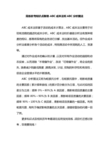
简练软考知识点整理-ABC成本法和ABC分析图法
ABC成本法即基于活动的成本计算法,ABC成本法主要用于对现有流程的描述和成本分析。
ABC成本法和价值链分析法有某种程度的相似,都是将现有的业务进行分解,找出基本活动。
但作业成本分析法着重分析各个活动的成本,特别是活动中所消耗的人工、资源等。
通过对作业成本的确认和计量,以及对所有作业活动的追踪和动态反映,从而消除“不增值作业”、改进“可增值作业”,将企业的损失、浪费减少到最低限度,提高决策、计划、控制的科学性和有效性,促进企业管理水平的不断提高。
ABC分析图法又称为帕累托分析,在帕累托图中,将影响质量的主要因素(累计频率曲线)的累计百分数分为三级,与此对应的因素分为三类:频率0%~80%为A类因素,是影响项目质量的主要因素;频率80%~90%为B类因素,是影响项目质量的次要因素;频率90%~100%为C类因素,是影响项目质量的一般因素。
利用帕累托图,有利于确定影响质量的主次因素,使错综复杂的问题一目了然。
更多知识点及相关历年考题请在应用宝找简练,项目忙还想过软考,您需要简练!
《简练APP》针对计算机技术与软件专业技术资格(水平)考试中的“信息系统项目管理师”和“系统集成项目管理工程师”两门考试,梳理历年真题、考试大纲、官方教程、知识点四者的动态关系,建立一体化的“学习-检测”系统,大纲为主线,教程为源点,知识点逐个击破,用真题检测。
《简练APP》将考试体系通过知识点划分成各个“小颗粒”知识点,为在繁忙工作中的考友,充分利用碎片时间进行学习,通勤地铁上、中午休息时、下午茶歇时、银行办事排队中。
这些零散的碎片时间,都可以简练备考学习。
- 1、下载文档前请自行甄别文档内容的完整性,平台不提供额外的编辑、内容补充、找答案等附加服务。
- 2、"仅部分预览"的文档,不可在线预览部分如存在完整性等问题,可反馈申请退款(可完整预览的文档不适用该条件!)。
- 3、如文档侵犯您的权益,请联系客服反馈,我们会尽快为您处理(人工客服工作时间:9:00-18:30)。
The Key Question: Does the amount of the activity cost pool increase with the number of units produced?
There is a no link between the cause of
9
support activity costs and the basis for assigning these costs to products Why? 1. Allocations are based on unit or volume related measures. 2. Different products consume different amounts of support activities.
Departmental Overhead Rates
Indirect Labor Indirect Materials Other Overhead
6
Stage One: Costs assigned to pools Cost pools
Department 1
Department 2
Department 3
4
Departmental Overhead Rates
5
Finishing Department Painting Department
Shipping Department
A two stage process is necessary because costs are allocated to departments and then to products.
Solution: Activity Based Costing
ACTIVITIES CONSUME RESOURCES PRODUCTS CONSUME ACTIVITIES
14
Activities are used to link resource costs
to products
Activity Based Costing (ABC)
The objective of activity-based costing is to understand the causes of overhead costs and to identify the real profitability of products and customers.
20
Identifying and Defining Activities 21
Unit-Level Activities Batch-Level Activities
An ACTIVITY is a part of the production process for which management wants a separate reporting of costs. Product-sustaining Activities Facility-sustaining Activities
Department 1
Direct Labour Hours
Department 2
Machine Hours
Department 3
Raw Materials Cost
Products
Departmental Allocation Bases
Cost Distortions caused by 2-stage allocations
Plantwide Overhead Rates
Companies have tended to use direct labour as the overhead application base.
However direct labour is now a relatively minor part of total manufacturing cost. Many tasks that used to be done by hand are now done by automated equipment.
Questionable profit margins
To compete in the marketplace, some
10
companies have had to cut the prices of high volume popular items. But They have been able to achieve high mark-ups on low volume specialty products.
ABC is a good supplement to our traditional cost system
15
I agree!
Activity Based Costing (ABC)
Activity-Based Costing
16
There are a number Both manufacturing of cost pools, each of and nonmanufacturing which is allocated costs may be using a unique assigned to measure of activity. products. Some manufacturing costs may be excluded from product costs.
Erosion of company profits
Price cuts produce increased sales in
11
units but decreased total revenue High mark-ups on specialty products didn’t offset the fall in profit margins of highvity Based Costing
ABC uses cost drivers that directly link
13
activities performed to products made. cost drivers are selected which measure the average demand placed on each activity by each product. activity cost pools are assigned to products in proportion to the way that they consume each activity.
Designing an ABC System
Cost Objects (e.g., products and customers)
19
Activities
Consumption of Resources
Cost
Designing an ABC System
Steps for Implementing ABC
Allocation bases often differ from traditional costing systems. Overhead rates may be based on activity at capacity.
How Costs are Treated Under Activity-Based Costing
Departmental Overhead Rates
Indirect Labor
Indirect Materials
7
Stage One: Costs assigned to pools Cost pools Stage Two: Costs applied to products
Other Overhead
1
Activity-Based Costing
Evolution of ABC
Conventional costing systems use a two-
2
stage allocation process: 1. service department costs are allocated to production departments. 2. production department overhead costs are allocated to products using a volume-based predetermined overhead rate.
18
cost objects and the performance of activities can help solve problems such as distorted product costs poor cost control the form of ABC adopted depends on the problems that need to be addressed
1. Identify and define activities and activity pools. 2. Where possible, directly trace costs to activities and cost objects. 3. Assign costs to activity cost pools. 4. Calculate activity rates. 5. Assign costs to cost objects. 6. Prepare management reports.
Department 1
Department 2
Department 3
Products
Departmental Overhead Rates
